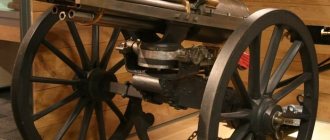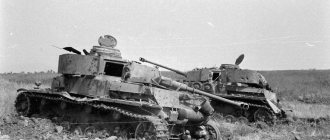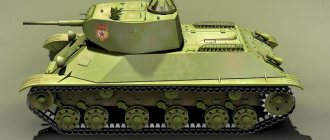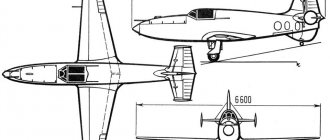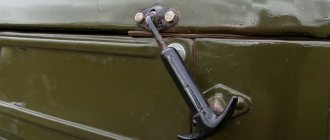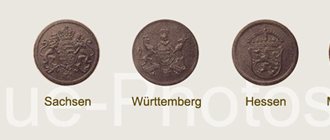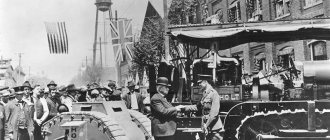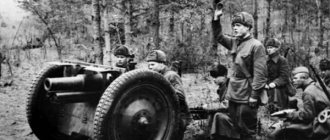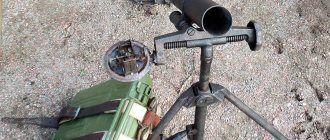Initially, the selection was made for myself, to make it easier to identify the tracks found, the most common tracks are present.
Tank T34:
Early "smooth" stamped track with a welded fang:
Track "with arrow":
“Waffle” track, width 500mm:
Truck produced in 1941:
Prefabricated “half track”:
Types of lugs (spurs) of the T-34 tank. You can see the “Single-bolt” spur, spurs for 500 mm and 550 mm tracks and the “universal” spur of the late version for both 500 mm and 550 mm tracks:
A detailed article about the types of tracks of the T-34 tank on the TopWar website (link will open in a new window)
KV tank tracks:
In total, there were 5 types of tanks of the KV line: - 700mm early - 608mm for the KV-1s - Chelyabinsk 650mm with composite tracks with shortened ridges randomly after 5-7 tracks - Chelyabinsk 650mm with composite tracks with completely cut ridges randomly after 5-7 tracks - 650mm late for KV-85. Used on pre-production and early IS-1s.
Early 700mm tracks:
SU-76:
Valentine:
The undercarriage of each side consisted of six rubber-coated road wheels, three of them interlocked into two balancing bogies with special springs and hydraulic shock absorbers; drive wheel with removable ring gear and two rubber tires; a guide wheel with a tensioning mechanism and three rubberized support rollers. The track chain had 103 tracks, and their engagement was lantern, in the middle of the track.
Tanks BT-2, 5, 7 (with a cylindrical turret):
The track chain consisted of 46 links (tracks), 23 flat and 23 with ridges. The link pitch was 255 mm, width was 260 mm. Each link had 13 lugs (7 on one side, 6 on the other). 6 track lugs with ridges were connected to 7 track lugs without ridges. The outer surface of the link was smooth.
BT-7 tanks (with conical turret)
The caterpillar chain consisted of 70 links (tracks). 35 flat and 35 with ridges Link pitch - 167 mm, width - 260 mm. Each link had 7 lugs (3 on one side, 4 on the other). 3 track lugs with ridges were connected to 4 track lugs without ridges. The outer surface of the link at the hinge joints has protrusions that rise above the supporting surface (lugs).
Light tank T-70:
Amphibious tanks T-37, T-38; tractor T-20 "Komsomolets":
The T-38 itself:
Tractor STZ-5:
Tractor "Comintern":
Wedge heel T27:
Produced in 1931-1933.
Where was the T 34 made?
The Soviet medium tank T-34 was developed in 1937–1940 at the design bureau of plant No. 183 (now the Kharkov Malyshev Transport Engineering Plant).
Interesting materials:
Can sauerkraut be stored at room temperature? Can champagne be stored at room temperature? Is it possible to store champagne at sub-zero temperatures? Can pickles be stored at room temperature? Can cheesecakes be stored at room temperature? Is it possible to store cottage cheese at sub-zero temperatures? Is it possible to glue wallpaper at low temperatures? Can honey be stored at sub-zero temperatures? Is it possible to wipe with alcohol at high temperatures? Is it possible to determine the temperature by touch?
Winter shoes
Tanks were born on the battlefields of the First World War, where they had to overcome not only enemy barriers, but also mud. Often the loss of a combat vehicle occurred not from enemy fire, but as a result of the tank being stuck in rough terrain. Even then, engineers and military personnel first thought about how to further increase the maneuverability of combat vehicles. Subsequently, the development of tanks went along the line of increasing mobility, and means of improving cross-country ability on soft soils almost did not advance beyond experiments. The issue of additionally increasing cross-country ability was returned to again during the Second World War. In addition to dirt, the tanks now had another “enemy” - snow. This problem became especially urgent on the Soviet-German front, where, for obvious reasons, there was the most snow.
Anti-swamp variations
The first attempts to make something that would further increase the maneuverability of tanks were made back in 1917. It quickly became clear that the tracks used on British tanks had insufficient traction with the ground. This often led to the tank getting stuck. As a solution to the problem, special spurs were created, which were attached to the tracks in an alternating manner. It is worth noting that the spur turned out to be somewhat wider than the track, so at the same time it was also the first widener. Spur extensions were first used on the Tank Mark II and can be seen on later models as well. However, extenders were not used on medium tanks, and they did not appear at all on British combat vehicles of the interwar period.
Tank Mark II with additional lugs. Their installation slightly increased cross-country ability on soft soils
During the interwar period, the need to further increase cross-country ability disappeared. In the 1920s, the British and Americans experimented with wide tracks that had wooden cushions, but they were not exactly wideners, and the matter still did not advance beyond the experimental tanks. Subsequent developments were aimed at increasing the mobility of combat vehicles, as well as increasing the service life of the tracks. In other cases, tracks completely stalled in their development - for example, in the case of Christie tanks. The wide flat track, which did not have pronounced lugs, behaved rather poorly on rough terrain. However, it lasted quite a long time on tanks of the BT family.
However, there was another problem that was not always paid attention to. There is such a parameter as specific ground pressure - the lower it is, the better the cross-country ability on soft soils. For the same BT-2, the specific pressure on the ground was 0.64 kg/cm2, it remained approximately the same on the BT-5, and on the BT-7 it had already increased to 0.73 kg/cm2. However, these were even more or less good indicators, like those of the T-26 (0.7 kg/cm2), as well as the T-28 (0.66 kg/cm2). However, already in the case of the T-26 they thought about a fairly high specific ground pressure. It is no coincidence that the T-46-1, which was supposed to replace the T-26, had wider tracks installed, which significantly reduced the specific ground pressure - to 0.56 kg/cm2. This turned out to be comparable to the specific pressure of the Pz.Kpfw.I Ausf.B (0.52 kg/cm2). In general, it should be noted that Soviet tank builders were very sensitive to the issue of maintaining the specific ground pressure parameters within reasonable limits. A specific ground pressure of about 0.9 kg/cm2 was considered very poor, and this mark was achieved extremely rarely.
Track extensions designed by factory No. 185. The option shown in the picture showed the most successful test results
However, good indicators of specific ground pressure did not always help. First of all, this concerned swampy terrain - not a rare phenomenon on the battlefield. On such soil, even wide tracks were often not enough, which was regularly demonstrated in tactical exercises. For this reason, since 1934, work began on the creation of various equipment designed to increase the maneuverability of tanks. Various variations on this theme were tested, starting with special “mats” and ending with special extensions for tracks. As a result, extenders became the best solution to the problem. They were either special tracks, on which there were special widenings, or original “spurs” attached to the tracks. Despite the fact that these devices were intended primarily for overcoming swampy terrain, they were also suitable for overcoming virgin snow (this was facilitated by a decrease in the specific pressure on the ground to 0.27-0.3 kg/cm2). This was already quite enough to confidently overcome very rough terrain. True, these extenders never made it into the series. The reasons were very different - both the complexity of the design and its fragility (during tests, the extenders were often deformed).
The extenders developed at STZ, similar to those developed by plant No. 185, never went into production
In the second half of the 30s, activity on track wideners came to naught. The topic became relevant again after the outbreak of the Soviet-Finnish War. The task of urgently solving this problem came to pilot plant No. 185 named after. Kirov. Based on the proposals of the designers Shufrin and Zhukov, three options for widening were developed, and in two cases not only wideners were installed, but also additional road wheels. Thus, the designers tried to get rid of one of the problems - rapid deformation of the extenders and their failure. The second option, developed by Zhukov, proved to be the most successful. However, it never made it into production - in the summer of 1940, work on extenders for the T-26 stopped. The same fate awaited the design developed at Seversky Plant under the leadership of N.D. Werner. It was a classic non-removable extension without additional road wheels. Thus, by the beginning of the Great Patriotic War, the Red Army had the greatest amount of work on the topic of swamp/snow extensions, but did not take advantage of these developments.
Experiments in the snow
After the start of the Great Patriotic War, there was no time for experiments at all. The main task was to maximize the production volume of tanks, as well as the deployment of their production at enterprises evacuated inland. In addition, the battles of the winter of 1941-1942 showed that the T-34 (the main tank of the Red Army at that time) did not really need track extenders to overcome snow drifts. Despite the fact that gradually, due to the increase in mass, the specific pressure on the ground increased, the T-34, according to Stalin, flew through the snow “like a swallow”
. The point was not only the wide track, but also the powerful engine, which made it possible to overcome virgin snow 40-60 cm deep. The situation with the KV-1 was worse, since the combat weight also grew, which is why it drove worse in the snow. However, in the case of the KV-1, no extensions would have helped - it required either increasing engine power or reducing combat weight.
The use of small tanks T-30 and T-60 showed that their ability to move through snow is limited
The situation with the small T-60 tank, which went into mass production in the fall of 1941, turned out to be much more complicated. This vehicle, created on the basis of an amphibious reconnaissance tank, was in many ways a substitute for the T-26. There is a myth that the T-60 supposedly moved well on the crust, but this is not true - in the winter of 1941-1942, completely different reports came from units. When the snow cover was more than 30 cm thick, the T-60, T-40 and the small T-30 tank developed on the same basis were stuck in the snow. In uneven terrain, the maximum thickness of the snow cover was 20-25 cm. Reports with similar content came from different sections of the fronts, so, alas, this was a pattern. In addition, at the end of 1941, work began to strengthen the armor protection of the T-60. Even the T-26 behaved better in such conditions - according to a report from the Southern Front at the beginning of 1942, this tank could overcome snow cover 30-40 cm thick.
Plates for T-30/T-60 tanks, developed by the design bureau of plant No. 37
In connection with the current situation, department No. 22 of design bureau of plant No. 37, evacuated to Sverdlovsk in the fall of 1941, began work on track extensions. The work was carried out in January 1942. At the factory itself, the track wideners were called plates. It’s somewhat funny that the width of the extender turned out to be the same as that of the T-26 - 520 mm. There was no need to do anything completely new, from the point of view of the tracks. The fact is that for the T-40/T-60 tracks there were spurs, and they were attached to holes drilled in the track. Thus, the tiles were screwed through the same holes in the tracks. The tiles themselves had drawing number 030.37.30, that is, in fact they were made not for the T-60, but for the T-30, which was being produced at factory No. 37 at that time. Each extender weighed 2 kg, and when installed on all tracks, the combat weight of the vehicle increased by 365 kg.
During the tests it turned out that the cross-country ability increased, but the design of the extenders itself turned out to be fragile
Tests carried out from March 27 to April 7, 1942 gave mixed results. Tests have shown that the specific pressure dropped to 0.26 kg/cm2, and immersion in snow was halved. It turned out that the maximum thickness of the snow cover was 85 cm. The speed of movement on the snow dropped by 10%, but against the backdrop of such an impressive depth of overcoming the virgin snow, this did not look very problematic. Much bigger problems emerged with the tiles themselves. Based on the test results, the design of the plates was considered unsuccessful, since insufficient adhesion and low reliability were noted. During 150 km of testing, 73 tiles were broken. Based on the test results, it was proposed to improve the design of the extenders, but the design did not receive further development. No other designs were developed for the T-60, and then for the T-70. By the way, the T-70 had a better situation with walking on snow, especially after the introduction of a reinforced chassis. It was not only a matter of a wider track, but also a higher combat weight, as well as an increased power density. As a result, the T-70 could make its way in snow 40-50 cm deep.
SU-76M produced by plant No. 40 with track extensions. NIBT Test Site, December 1943
As often happens, the lack of factory methods for solving problems was solved by field improvisation. In particular, for the T-34 they made improvised track extenders using a half-idler track paired with a regular single track. Also, instead of spurs, wooden blocks could be attached. Despite the fact that such designs were not highly reliable, they became, so to speak, serial Soviet extenders. True, they were used more often for soft soils, and not when driving on virgin snow.
A total of 92 extensions were installed on the machine.
A new attempt to use winter track wideners was made at the end of 1943. By that time, the Soviet industry had stopped producing light tanks, but the SU-76 was produced (on the same base as the T-70B). Despite the fact that the vehicle received wider tracks, due to the increase in mass, the specific pressure on the ground increased to 0.54 kg/cm2. And the power density has not become higher compared to the T-70/T-70B. In a word, problems with overcoming deep snow remained relevant.
The design of the expander was quite simple, and its installation took 20-30 man-hours
In the case of the SU-76M, the work on creating track extenders was undertaken by the team of the design bureau of plant No. 40 NKSM (Mytishchi). The idea that was implemented there was in many ways reminiscent of the pre-war developments of plant No. 185. Instead of making a completely new track, factory No. 40 decided to make removable extensions. They were a fairly simple design, consisting of 6 parts, the total weight of one extender was 2.6 kg. To install the extender, two fingers on the tracks were removed, and a “fork” was installed instead. The extensions themselves required fewer than in the case of the design of plant No. 37 - 92 pieces per vehicle.
Extender installation diagram
After installing the extensions, the width of the tracks increased to 550 mm. The installation itself was not an extremely difficult task. According to the results of tests at the NIBT Test Site, which took place in December 1943, on average, installing a full set of extenders required 25-30 man-hours. It took about the same amount to remove them. It was noted that installation and dismantling do not cause significant inconvenience. However, a more important parameter was reliability of operation, as well as efficiency. In this regard, the SU-76M, equipped with extenders, passed the test program at the NIBT Test Site.
Typical deformation of extensions during testing at the test site
According to the approved test program, the car covered a typical 500 km, of which 50 km on an asphalt highway, another 200 on a cobblestone highway and 250 on a country road. The program also included special tests on the strength of extenders. It was separately stipulated that the tests were carried out at the maximum speed of the machine. Frankly speaking, the conditions are not the best, given that the extenders were intended primarily to overcome difficult terrain. Therefore, the test results were a little predictable.
But this is how these deformations were formed. The only question that arises is: “What was that?”
First of all, it was necessary to check the operation of the extensions in snowy terrain, so the first thing the car did was head out onto the dirt road. The conditions were not at all those for which these extenders were intended - the thickness of the snow cover did not exceed 100-150 mm. Judging by the report, there was no check of driving in deep snow at all; instead, the car was driving at maximum speed along a country road. Over 250 km of travel at an average speed of 15.5 km/h, 8 expanders collapsed. The special tests consisted of driving over logs (with obvious results).
Condition of the extensions after the run. I wonder if those who did the testing were told what these extenders were made for?
In total, during testing, the SU-76M with extenders covered 320 km. During this time, 42 extensions failed, 34 of them while driving on the highway. Based on the test results, the extenders were rejected, but, frankly speaking, the tests themselves raise a lot of questions and outright bewilderment. For some reason, I remember a joke about harsh Siberian lumberjacks and a Japanese chainsaw. There was simply no testing of the operation of the extenders in the area for which they were created - it seems that the tests were just for show. There was only one result - work on track extensions for the SU-76M was stopped.
Testing winter tracks on a prototype ISU-122
Around the same time, tests were carried out on a prototype of the Object 242 self-propelled artillery mount (the future ISU-122). Experimental “winter” tracks were installed on it. The most interesting thing is that nothing is said at all about the design of these tracks, including in the reports on the experimental work of plant No. 100, which developed them. The team at plant No. 100 also included former employees of pilot plant No. 185, who were engaged in similar developments before the war, but these “winter” tracks had nothing to do with them. In this design, the German Winterketten are easily guessed, which will be discussed below. It was a single track of a stamped design, which, like the German prototype, had reinforcement ribs on the working side. To reduce weight, there were recesses on the inside of the extensions.
The design of these tracks was very similar to the Winterketten
Tests of Object 242 took place at the Gorokhovets ANIOP from December 24 to December 30, 1943. The priority was testing the A-19 system installed in the self-propelled guns, so little attention was paid directly to sea trials. At the same time, they have already shown that the idea of the Soviet Winterketten is meaningless. As a matter of fact, conventional tracks did not behave in the best way, and therefore experimental work was carried out to create a track with a longer resource. What can we say about the tracks with extenders, which bore an even greater load. Even at a short distance during sea trials, about a quarter of the track extensions were broken.
The survivability of the extenders turned out to be low
No further work on track wideners was carried out during the Great Patriotic War. Firstly, the results of previous tests had an impact. Secondly, by the autumn of 1944, the Red Army found itself in territories where the issue of increasing cross-country ability in snow was simply not relevant. Thus, during the Great Patriotic War, such experiments ended in nothing. The troops solved the problems of passing through difficult areas on their own, however, as already mentioned, usually it was a question of “swamp” extenders.
Foreign analogues
Against the backdrop of ambiguous results of work on Soviet track wideners, one may get the erroneous impression of a complete failure. In fact, the situation is not as clear-cut as it might seem. Firstly, Soviet tanks, especially the T-34, performed well in winter conditions. Against their background, foreign combat vehicles clearly gave in, as shown by the results of field tests. Secondly, similar work was carried out in other countries, and the results most often turned out to be very similar.
German widened tracks, better known as Winterketten
The Germans achieved the greatest success in developing “winter” tracks. This is not surprising, since it was the Germans who had the worst situation with regard to the maneuverability of tanks on soft soils. As mentioned above, in Soviet tank building a specific ground pressure of 0.9 kg/cm2 was considered very high, and measures were taken to reduce it. Meanwhile, the Germans were doing very poorly with specific ground pressure. Initially, everything was quite good: the Pz.Kpfw.III Ausf.A had a specific ground pressure of 0.68 kg/cm2, and the Pz.Kpfw.IV Ausf.A had very similar figures. The problem was that the combat weight of the tanks was growing due to increased armor protection. Therefore, for the Pz.Kpfw.III Ausf.E/F the specific pressure on the ground increased to 0.9 kg/cm2, and for the Pz.Kpfw.IV Ausf.D - to 0.83 kg/cm2. And this was just the beginning: the Pz.Kpfw.III Ausf.H, even after installing slightly wider tracks, had a specific ground pressure of 1 kg/cm2. It is not surprising that in comparative tests, which were carried out in 1942 at the NIBT Test Site, this tank showed the worst cross-country ability, especially on swampy ground.
The Pz.Kpfw.IV Ausf.F had a better situation - the specific pressure was 0.88 kg/cm2, which is only slightly higher than that of the T-34. Due to the increase in armament and combat weight on the Pz.Kpfw.IV Ausf.G, the specific ground pressure increased to 0.93 kg/cm2, which is more than that of the KV-2. However, this was still better than that of the Pz.Kpfw.III Ausf.J/N, where the specific ground pressure exceeded one. The same applied to the StuG III/StuG 40 - for example, the StuG 40 Asuf.G had a specific ground pressure of 1.04 kg/cm2. With such indicators, you can roughly imagine what happened to cars on soft ground, not to mention snow.
The difference between Winterketten and Soviet “winter” tracks was the developed reinforcement ribs, which made the structure more durable
What was happening forced us to quickly solve the problem. In 1942, tracks were developed and designated Winterketten. The Germans did not come up with anything fundamentally new. The standard Kgs 61/400/120 track received additional widening similar to what was developed for the T-26 track at STZ in 1940. To reduce weight on the inside, the widening was hollow, and a stiffening rib appeared on the working surface. It is not entirely clear when exactly the Winterketten were developed, but with a high degree of probability we are talking about the summer of 1942. Just at this time, significant improvements to the winter equipment on the Pz.Kpfw.III and Pz.Kpfw.IV took place.
Winterketten were unified for Pz.Kpfw.III and Pz.Kpfw.IV, as well as for vehicles based on these chassis
Since the Kgs 61/400/120 track was standard for the Pz.Kpfw.III and Pz.Kpfw.IV, it was easily installed on these tanks, as well as self-propelled guns produced on their basis. Winterketten first appeared at the front at the end of 1942. No details of their use have been preserved, but analysis of photographs gives grounds for not the best conclusions. Of course, cross-country ability has increased, but Winterketten’s problems turned out to be the same as those of the wideners developed in the Soviet Union. During intensive use, the extensions bent and broke off. The problem was mitigated by the fact that the combat weight of German tanks and self-propelled guns was somewhat less than that of the Soviet T-34. However, the apogee of Winterketten use came in the winter of 1942-1943, and then abruptly faded away. In the winter of 1943-1944, Winterketten were used sporadically. At the same time, mass production of a variation on this theme began - Ostketten. Less wide, these tracks turned out to be less susceptible to damage. However, they also met sporadically.
There are no in-depth reports on tests of German tracks with extensions. However, pictures like these speak eloquently about everything - the extenders bent and broke off in the same way
American medium tanks experienced similar problems. The Medium Tank M3 had a specific ground pressure of 0.885 kg/cm2; in 1942 tests, it did not perform much better than the PzIII Ausf.H. As for the Medium Tank M4, its specific pressure has become even higher - 0.962 kg/cm2. At first, there were no special problems (at least for the Americans themselves), however, work began on wider tracks at the end of 1942. There were two directions - a completely new track, as well as extensions that were attached to ridge connectors. As a result, both options were implemented.
American-style solution to the problem of excess specific pressure. This design was used on both light and medium American tanks
For tanks with conventional tracks, a comb connector 7055614 was developed, which was put into production in 1944. This item existed in several versions. Such extenders were used not so much in snow as in mud, showing positive results. Tracks for tanks with HVSS suspension have proven to be even more effective. For example, the Medium Tank M4A3E8 with a combat weight of 33.7 tons had a specific ground pressure of 0.772 kg/cm2.
Track extenders, which reduced the specific pressure to 0.49 kg/cm2
There was, however, a third, experimental option, which was strongly reminiscent of Soviet developments of the mid-30s. In April 1944, the Weapons Department launched a program to develop track extenders. Thanks to them, the total track width has increased to 826 mm. These tracks were suitable for both conventional T51 and a design that had a ridge connector 7055614. In the latter case, the overall width increased to 940 mm, and the specific pressure decreased to 0.49 kg/cm2.
The extensions were attached quite easily and also easily removed. Alas, they arrived too late
Tests carried out at the beginning of 1945 turned out to be quite successful. Basically, the extenders were intended for use in swamp conditions, but in general they were also suitable for overcoming deep snow. In February 1945, an order followed for the production of 1000 sets of such extenders, but the end of the war crossed out these plans. Thus, the Germans were the only ones who launched “winter” tracks into production and used them for their intended purpose. However, as already mentioned, the results of operating Winterketten were not the best.
Sources:
- TsAMO RF
- RGAE
- Central State Archive of St. Petersburg
- USNARA
- Photo archive of the author
